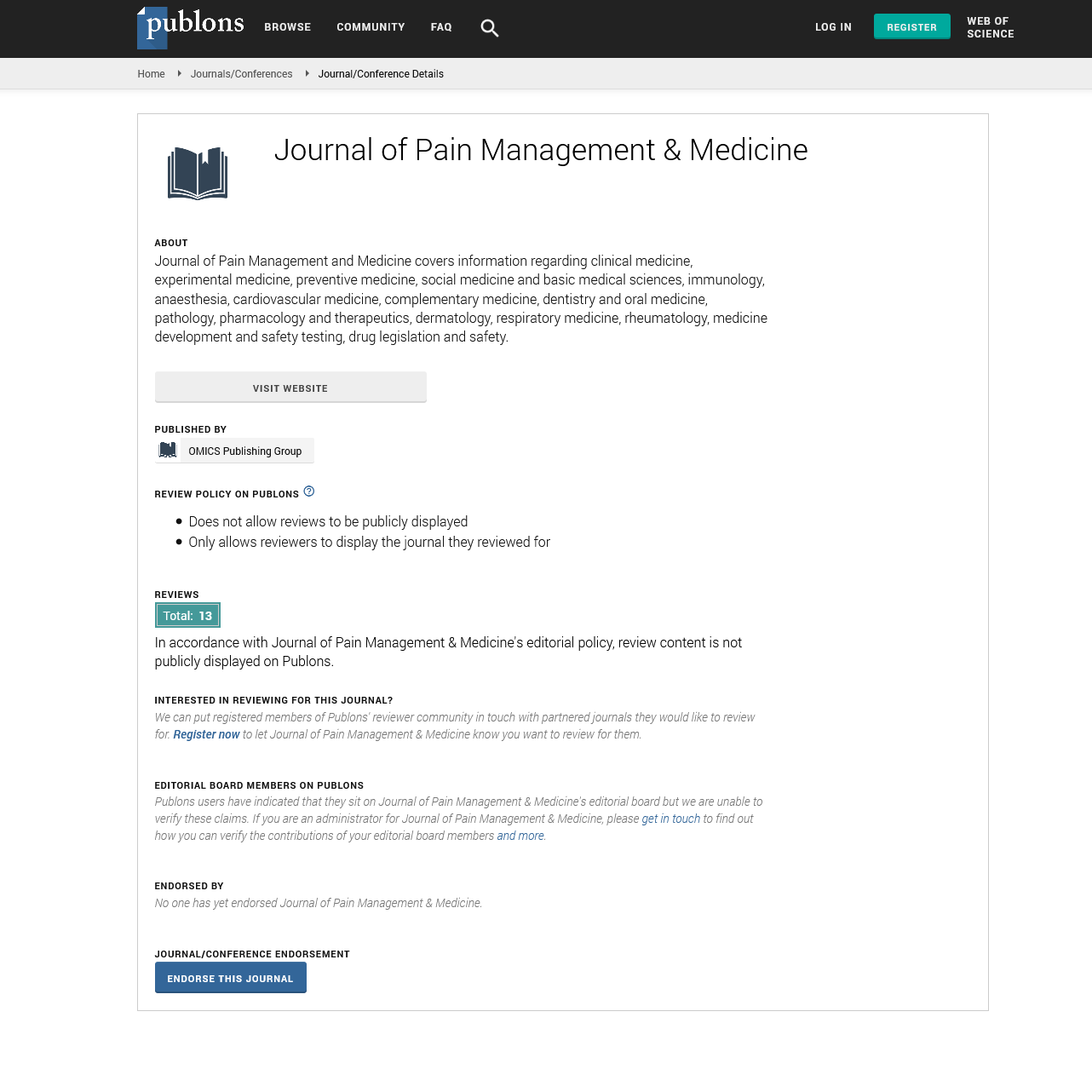Indexed In
- RefSeek
- Hamdard University
- EBSCO A-Z
- Publons
- Euro Pub
- Google Scholar
- Quality Open Access Market
Useful Links
Share This Page
Journal Flyer

Open Access Journals
- Agri and Aquaculture
- Biochemistry
- Bioinformatics & Systems Biology
- Business & Management
- Chemistry
- Clinical Sciences
- Engineering
- Food & Nutrition
- General Science
- Genetics & Molecular Biology
- Immunology & Microbiology
- Medical Sciences
- Neuroscience & Psychology
- Nursing & Health Care
- Pharmaceutical Sciences
Commentary Article - (2024) Volume 10, Issue 5
Cancer Pain: Addressing the Physical and Emotional Challenges
Ramm Hesse*Received: 26-Aug-2024, Manuscript No. JPMME-24-27467; Editor assigned: 28-Aug-2024, Pre QC No. JPMME-24-27467 (PQ); Reviewed: 11-Sep-2024, QC No. JPMME-24-27467; Revised: 18-Sep-2024, Manuscript No. JPMME-24-27467 (R); Published: 25-Sep-2024, DOI: 10.35248/2684-1320.24.10.292
Description
Cancer is one of the most serious and complex diseases frequently associated with a wide range of symptoms that can significantly affects a patient’s quality of life. Among these symptoms, cancer-related pain stands out as one of the most distressing, impacting both physical and emotional well-being.
Nature and types of cancer pain
Cancer pain can vary widely in intensity, location and duration. It is frequently classified into three types. Nociceptive pain is a type of pain occurs when cancer invades tissues or organs, stimulating pain receptors in the affected areas. Nociceptive pain is additionally divided into somatic and visceral pain. Somatic pain originates in the bones, muscles or skin and is usually described as sharp, aching or throbbing. Visceral pain arises from internal organs such as the stomach, liver or intestines and is generally described as a deep, cramping or squeezing sensation.
Neuropathic pain results from nerve damage caused by the cancer treatments, such as chemotherapy or radiation therapy. This type of pain is frequently described as burning, shooting or tingling and it may be more challenging to treat than nociceptive pain. Neuropathic pain can be persistent or intermittent and it may arise even when no external stimuli are present.
Breakthrough pain refers to sudden, intense episodes of pain that occur even when a patient is already taking medication to control chronic cancer pain. Breakthrough pain can last anywhere from a few minutes to several hours and frequently requires additional medication or adjustments in pain management techniques to maintain it under control.
Causes of cancer pain
Cancer pain may be caused by the tumor treatments or complications related to the disease. Understanding the underlying cause of the pain is essential for developing appropriate treatment strategies.
Tumor growth and invasion: As tumors grow, they can invade and compress nearby tissues, organs or nerves, causing pain. For example, bone metastases (when cancer spreads to the bones) are a common source of cancer-related pain. Tumors pressing against nerves, muscles or other organs can also lead to significant discomfort.
Cancer treatments: Treatments for cancer, including surgery, chemotherapy and radiation therapy, can sometimes cause pain. Surgery can result in post-operative pain from the incision site or tissue trauma. Chemotherapy can cause neuropathy, particularly in the hands and feet, as some chemotherapeutic drugs damage peripheral nerves. Radiation therapy may lead to pain in the treated area, especially if it causes inflammation, tissue damage or fibrosis (thickening of tissues).
Infection or inflammation: Cancer patients, especially those with compromised immune systems due to chemotherapy or radiation, are at higher risk of infections, which can result in pain. Inflammation caused by the immune response to cancer can also contribute to pain, particularly in the case of cancers that trigger inflammatory processes, such as pancreatic cancer.
Cancer-related complications: Other complications, such as blood clots, fractures due to weakened bones (pathologic fractures) or bowel obstructions, can cause acute pain. These consequences are frequently caused by cancer, but they require being treated immediately as possible in order to avoid additional pain.
The effect of cancer pain on quality of life
Uncontrolled cancer pain can have life-threatening consequences on a patient’s quality of life. It can interfere with daily activities, disrupt sleep and lead to a loss of independence. Patients may become less able to engage in important activities, which can contribute to feelings of isolation, depression and despair. The psychological impact of living with constant or severe pain can be immense. Anxiety about future pain episodes, fear of worsening symptoms and concerns about becoming dependent on pain medications can heavy weight on patients and their families.
Citation: Hesse R (2024). Cancer Pain: Addressing the Physical and Emotional Challenges. J Pain Manage Med.10:292.
Copyright: © 2024 Hesse R. This is an open access article distributed under the terms of the Creative Commons Attribution License, which permits unrestricted use, distribution and reproduction in any medium, provided the original author and source are credited.

